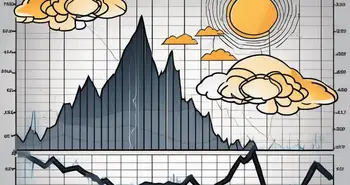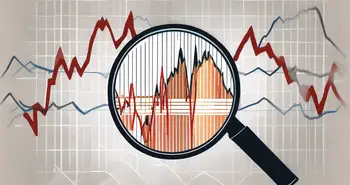What Is Market Cap: A Comprehensive Guide to Understanding Market Capitalization

Market capitalization, or market cap, is a fundamental concept in finance that plays a crucial role in understanding investment opportunities. Whether you are new to investing or a seasoned pro, grasping the basics of market cap is essential. In this comprehensive guide, I will explain what market cap is, how it is calculated, its importance in investing, and much more. So let's dive in!
Understanding the Basics of Market Capitalization
Before we delve into the details, let's start with the definition of market cap and its significance in investment analysis.
Market capitalization refers to the total value of a company's outstanding shares of stock. It is calculated by multiplying the current share price by the total number of shares outstanding. The resulting figure represents the market's perception of a company's worth.
Market cap provides investors with valuable insight into a company's size and growth potential. It is an indicator of the company's market value and can help determine its position within the investment landscape. Understanding market cap allows investors to identify and evaluate investment opportunities based on their risk tolerance and investment goals.
Investors often categorize companies into different market cap ranges, such as large-cap, mid-cap, and small-cap. Large-cap companies typically have a market cap of over $10 billion, while mid-cap companies range from $2 billion to $10 billion, and small-cap companies have a market cap below $2 billion. These categorizations can help investors tailor their investment strategies to specific market segments.
To calculate market cap, you simply multiply the share price by the number of outstanding shares. For example, if a company has 1 million shares outstanding and the current share price is $50, the market cap would be $50 million (1 million shares x $50).
It's important to note that market cap is a dynamic value that can change in response to various factors, including changes in the stock price and the number of outstanding shares. As a result, market cap is often used in conjunction with other financial metrics to gain a comprehensive understanding of a company's value and investment potential.
Investors also consider market cap when constructing a diversified portfolio. By including companies with different market caps, investors can balance their risk and potential returns. Large-cap stocks tend to be more stable and offer steady growth, while small-cap stocks can be more volatile but offer higher growth potential.
In addition to market cap, investors may also analyze other factors such as price-to-earnings ratio (P/E ratio), earnings per share (EPS), and dividend yield to assess a company's financial health and performance. These metrics, when combined with market cap, provide a more comprehensive picture of a company's investment potential.
In conclusion, market capitalization is a fundamental concept in investment analysis. It provides investors with valuable insights into a company's size, growth potential, and market value. By understanding market cap and considering it alongside other financial metrics, investors can make informed decisions and build a well-rounded investment portfolio.
Different Categories of Market Cap
Market cap categories are used to classify companies based on their size. Let's explore the three main categories: small cap, mid cap, and large cap.
When it comes to investing in the stock market, understanding the different categories of market capitalization can be crucial. Market capitalization, or market cap, is a measure of a company's value and is calculated by multiplying the number of outstanding shares by the current market price per share. It provides investors with an idea of the size and scale of a company.
Small Cap Companies
Small cap companies typically have a market capitalization of less than $2 billion. These companies are often in the early stages of growth and can offer high growth potential, albeit with higher risk. Due to their smaller size, small cap companies have the ability to adapt quickly to market changes and can be more nimble in their decision-making processes.
Investing in small cap companies can be rewarding, but it requires careful analysis and a willingness to tolerate greater volatility. These companies may have limited financial resources and may face challenges in accessing capital markets. However, successful small cap investments can lead to significant returns, as these companies have the potential to grow rapidly and become mid or large cap companies over time.
Mid Cap Companies
Mid cap companies have a market capitalization between $2 billion and $10 billion. They are often considered a balance between small cap and large cap companies in terms of risk and growth potential. Mid cap stocks can offer a combination of stability and growth, making them attractive to investors seeking a diversified portfolio.
Mid cap companies are generally more established than small cap companies, with a proven track record of success. They have already gone through the initial growth phase and have the potential to continue expanding their market share. These companies may have a more defined business model and a broader customer base, which can contribute to their stability.
Large Cap Companies
Large cap companies have a market capitalization exceeding $10 billion. These are well-established companies, often household names, with a track record of stability. Large cap stocks are typically less volatile than small or mid cap stocks and are often considered a core holding for long-term investors.
Investing in large cap companies can provide investors with a sense of security, as these companies are usually leaders in their respective industries. They often have a global presence, diversified revenue streams, and strong brand recognition. Large cap companies may also offer regular dividend payments, providing investors with a steady income stream.
While large cap companies may not experience the same level of growth as small or mid cap companies, they can still generate solid returns over the long term. These companies have the resources to weather economic downturns and are more likely to withstand market volatility.
It's important to note that market capitalization is not the only factor to consider when making investment decisions. Other factors such as industry trends, financial performance, management team, and competitive landscape should also be taken into account.
In conclusion, understanding the different categories of market cap can help investors make informed decisions and build a well-diversified portfolio. Small cap companies offer high growth potential but come with higher risk, while mid cap companies provide a balance between risk and growth. Large cap companies, on the other hand, offer stability and are often considered a core holding for long-term investors. By considering these categories and conducting thorough research, investors can navigate the stock market with confidence.
Market Cap vs. Other Valuation Metrics
While market cap is an important metric, it is not the only one investors should consider. Let's compare market cap to other valuation metrics to gain a deeper understanding.
Market Cap vs. Enterprise Value
Market cap measures the equity value of a company, while enterprise value takes into account both equity and debt. Enterprise value provides a more comprehensive understanding of a company's total value, considering its debt obligations. Investors should consider both market cap and enterprise value to assess a company's overall valuation.
Market Cap vs. Book Value
Book value represents the net value of a company's assets after subtracting liabilities and intangible assets. While market cap reflects the market's perception of a company's worth, book value provides insight into its intrinsic value. Investors often compare a company's market cap to its book value to determine if it is over- or undervalued.
The Role of Market Cap in Portfolio Management
Market cap plays a crucial role in portfolio management, helping investors diversify their holdings and manage risk.
Diversification and Market Cap
By investing in companies with different market caps, investors can diversify their portfolios. This diversification helps reduce the impact of market volatility and spreads risk across a range of companies with different growth potential and risk profiles.
Risk and Return in Relation to Market Cap
Each market cap category carries its own level of risk and potential return. Small cap stocks have higher growth potential but are accompanied by increased risk. Large cap stocks tend to offer more stability but may have slower growth. Understanding the risk-return trade-off associated with different market caps is crucial for effective portfolio management.
Misconceptions and Misuses of Market Cap
While market cap is a valuable tool, it is essential to be aware of its limitations and avoid common misconceptions.
Limitations of Market Cap as a Valuation Tool
Market cap alone is not sufficient to evaluate a company's investment potential. It does not consider factors such as debt, profitability, or industry dynamics, which can significantly impact a company's performance and valuation. Investors should analyze multiple factors in conjunction with market cap to make informed investment decisions.
Common Misinterpretations of Market Cap
It is important to remember that market cap does not reflect the liquidity or tradability of a stock. While large cap stocks are typically more liquid, small cap stocks can also have adequate liquidity depending on their trading volume. Additionally, market cap should not be used to determine a company's future growth potential or its ability to generate profits.
Personal Advice: Having studied the intricacies of market cap and its implications for years, I can confidently say that it is a valuable metric to consider when making investment decisions. However, remember to use market cap in conjunction with other relevant factors and conduct thorough research before making any investment commitments. Developing a well-diversified portfolio that aligns with your risk tolerance and investment goals is key to long-term success in the world of investing.
FAQ
What is market cap?
Market cap refers to the total value of a company's outstanding shares of stock. It is calculated by multiplying the current share price by the total number of shares outstanding.
Why is market cap important?
Market cap provides investors with insight into a company's size and growth potential. It helps determine the company's position within the investment landscape and allows investors to evaluate investment opportunities based on their risk tolerance and investment goals.
How is market cap calculated?
Market cap is calculated by multiplying the share price by the number of outstanding shares.
What are the different categories of market cap?
The three main categories of market cap are small cap, mid cap, and large cap. Small cap companies have a market capitalization of less than $2 billion, mid cap companies have a market capitalization between $2 billion and $10 billion, and large cap companies have a market capitalization exceeding $10 billion.
Is market cap the only valuation metric to consider?
No, market cap is not the only valuation metric to consider. Other metrics, such as enterprise value and book value, provide additional insights into a company's valuation and worth.
What are the common misconceptions of market cap?
Some common misconceptions about market cap include using it as the sole indicator of a company's worth, misinterpreting market cap as a measure of liquidity, and solely relying on market cap to predict a company's future growth potential.
In conclusion, market cap is a vital concept in investing that provides valuable information about the size and growth potential of a company. By understanding market cap and considering it alongside other relevant factors, investors can make informed decisions and build well-diversified portfolios. Remember, investing in the stock market involves risks, and thorough research is essential before committing your hard-earned money.
Ready to take your understanding of market capitalization and apply it to a world of trading possibilities? Discover Morpher.com, where the fusion of blockchain technology and innovative trading solutions opens up a new realm of investment opportunities. With Morpher, you can trade a vast array of assets, from stocks and cryptocurrencies to unique markets, all with zero fees and infinite liquidity. Embrace the power of fractional investing, short selling, and up to 10x leverage to enhance your portfolio. Plus, enjoy the peace of mind that comes with the secure, non-custodial Morpher Wallet. Experience the future of trading on a platform designed for investors who demand more. Sign Up and Get Your Free Sign Up Bonus today, and join the Morpher community in reshaping the investment landscape.

Disclaimer: All investments involve risk, and the past performance of a security, industry, sector, market, financial product, trading strategy, or individual’s trading does not guarantee future results or returns. Investors are fully responsible for any investment decisions they make. Such decisions should be based solely on an evaluation of their financial circumstances, investment objectives, risk tolerance, and liquidity needs. This post does not constitute investment advice.

Painless trading for everyone
Hundreds of markets all in one place - Apple, Bitcoin, Gold, Watches, NFTs, Sneakers and so much more.

Painless trading for everyone
Hundreds of markets all in one place - Apple, Bitcoin, Gold, Watches, NFTs, Sneakers and so much more.









